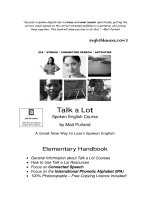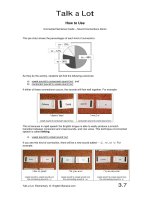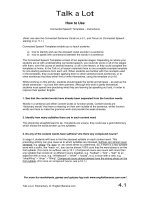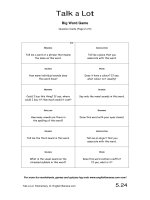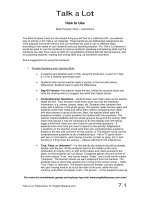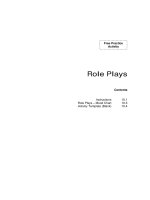Tài liệu Spoken english elementary handbook part 10 ppt
Bạn đang xem bản rút gọn của tài liệu. Xem và tải ngay bản đầy đủ của tài liệu tại đây (185.07 KB, 15 trang )
Role Plays
Contents
Instructions 10.1
Role Plays – Mood Chart 10.3
Activity Template (Blank) 10.4
Free Practice
Activity
Talk a Lot
How to Use
Role Plays – Instructions
For more fun worksheets, games and quizzes log onto www.englishbanana.com now!
Talk a Lot Elementary © English Banana.com
10.1
Students work in pairs or groups of three to develop and rehearse a short role play with three
scenes, based on the information given to them on the handout, which is then performed to
the rest of the class. They have to include the title of the outline somewhere in their role play,
e.g. Family role play 1 (from Book 1): “You did that on purpose!” The role play can be fully
acted out, with props and costumes, or be simply a dialogue that students perform whilst
sitting at their desks, but students shouldn’t be writing during this activity. Writing can be done
at home. In Talk a Lot lessons the focus should be mainly on spoken English. The teacher
should always ensure that students understand what they have to do and are confident with
the vocabulary used on the role play handout before they begin. The teacher should insist
that each group produces three different, distinct scenes, teaching them to think of the role
play as three parts of a whole, with a through-line and a logical progression through the
scenes, for example:
• Scene 1: Setting up the situation
• Scene 2: Action
• Scene 3: Result
To make this task more challenging, you could agree as a group that all role plays have to
include particular things, as well as what is in the outline, for example:
a) a person’s name
b) a place name
c) an object (e.g. an aubergine or a giraffe’s toothbrush)
d) a certain phrase
e) a prop
f) a costume
The teacher could provide a costumes box and a prop box in the classroom with plenty of
dressing up clothes or objects for students to use in their role plays.
If your students particularly enjoy doing role plays, they could try the role play extensions in
Books 1 and 2, and those which are included with each handout (for Book 3 onwards), in
addition to the role play outlines on the handouts. However, role play must be only one
element of a Talk a Lot lesson, i.e. free practice. Make sure that in each lesson there is a
balance of activities, for example: tests, sentence block building, sentence focus
activities, word focus activities, and free practice activities.
It’s fine too if students want to veer away from the outlines given on the handouts. The aim of
the activity is for the students to put the flesh on the bare bones of the outlines. For example,
they should suggest character names, place names, names of businesses, and so on. The
suggested outlines are only there to get ideas flowing and to get students talking. The teacher
could suggest new situations for role plays or more imaginative groups of students could think
up new role plays of their own (based on the same lesson topic), using the blank template on
p.10.4.
The Mood Chart
Use the mood chart on p.10.3 to add an extra dimension to the role plays. Print the page onto
card, cut up the cards and put them into a bag. Each student picks one card – one mood –
Talk a Lot
How to Use
Role Plays – Instructions
For more fun worksheets, games and quizzes log onto www.englishbanana.com now!
Talk a Lot Elementary © English Banana.com
10.2
and they have to act out their role play using this mood exclusively. When watching each role
play the audience have to guess which moods the actors have picked. In another variation,
the audience pick the moods that they want to see used in a role play, or all the
groups have to rehearse the same role play using different moods, and the audience have to
guess what they are.
Note: the students could also add their own suggestions to the moods given on the Mood
Chart.
Assessment
Assessment is performed by the teacher checking and correcting during the task, listening for
errors that can be dissected later on in a group feedback session, giving individual as well as
group feedback, and referring students back to:
a) the grammar they are learning from forming the sentence blocks, and building
sentences
b) the pronunciation work they are doing using the techniques of connected speech and
the IPA
Each student’s achievement in this activity is also recorded as part of their overall lesson
score (for both accuracy and effort) by the teacher on their course report.
Because this activity is drama-based, the audience could make their voice heard too, perhaps
by giving marks out of ten for each role play based on:
• language accuracy
• effort
• imagination
• best costumes, use of props, lighting, sound, etc.
Or they could give thumbs up (1 or 2) or thumbs down (1 or 2). The audience feedback is just
for fun and not to be recorded on each student’s course report.
Talk a Lot
How to Use
Role Plays – Mood Chart
For more fun worksheets, games and quizzes log onto www.englishbanana.com now!
Talk a Lot Elementary © English Banana.com
10.3
I’m feeling…
nosy
bored
relieved
cheerful
angry
happy
shocked
up
frightened
smug
apologetic
secretive
confused
worried
so so
aggressive
guilty
ecstatic
paranoid
naughty
surprised
energetic
friendly
unwell
depressed
moody
determined
tired
giggly
upset
mischievous
disgusted
My suggestions:
___________
___________
___________
___________
___________
___________
___________
___________
Talk a Lot
Topic: __________________
For more fun worksheets, games and quizzes log onto www.englishbanana.com now!
Talk a Lot Elementary © English Banana.com
10.4
Role Plays
1. Title: ________________________________________
Place: ___________________________ Time: ___________________________
Characters: ____________________________________________________________
Situation: ____________________________________________________________
____________________________________________________________
Scenes: i) __________________________________________________________
ii) __________________________________________________________
iii) __________________________________________________________
If there are three people in the group the third character could be:
a) __________________________________________
b) __________________________________________
c) __________________________________________
2. Title: ________________________________________
Place: ___________________________ Time: ___________________________
Characters: ____________________________________________________________
Situation: ____________________________________________________________
____________________________________________________________
Scenes: i) __________________________________________________________
ii) __________________________________________________________
iii) __________________________________________________________
If there are three people in the group the third character could be:
a) __________________________________________
b) __________________________________________
c) __________________________________________
C Focus on Connected
Speech
Contents
What is Connected Speech? 11.
What is Connected Speech? (Student’s Handout) 11.1
The Techniques of Connected Speech 11.3
The Techniques of Connected Speech – Matching Game 11.8
What is Sentence Stress? 12.
What is Sentence Stress? 12.1
Sentence Stress in Starting Sentences from Elementary Book 1 12.6
Stressed Syllables in Starting Sentences from Elementary Book 1 12.9
Stressed Syllables & Vowel Sounds in Starting Sentences from Elementary Book 1 12.12
Sentence Stress in Starting Sentences from Elementary Book 2 12.17
Stressed Syllables in Starting Sentences from Elementary Book 2 12.20
Stressed Syllables & Vowel Sounds in Starting Sentences from Elementary Book 2 12.23
List of Common Contractions in English 12.28
Sentence Stress – Activity Cards (Blank) 12.29
What is Word Stress? 13.
What is Word Stress? 13.1
Analysis of Discussion Words in Elementary Book 2 13.3
Discussion Words with Suffixes in Elementary Book 2 13.6
Working Out Word Stress – Analysis of a Newspaper Article #1 13.7
Working Out Word Stress – Two-Syllable Words where the First Syllable is a Schwa: L]L
13.8
Prefixes 14.
Common Prefixes and What they Indicate 14.1
Common Prefixes and What they Indicate – Matching Game 14.2
List of Noun/Verb Homographs 14.3
Suffixes 15.
Common Suffixes and What they Indicate 15.1
Common Suffixes and What they Indicate – Matching Game 15.2
Suffixes and Word Stress 15.4
Compound Nouns 16.
300 Common Compound Nouns – Ordered by Same First Word 16.1
Compound Nouns – Activity Sheet (First Words) 16.2
Compound Nouns – Activity Sheet (First Words) – Answers 16.3
300 Common Compound Nouns – Ordered by Same Second Word 16.4
Compound Nouns – Activity Sheet (Second Words) 16.5
Compound Nouns – Activity Sheet (Second Words) – Answers 16.6
Weak Forms 17.
Weak Forms – Information Sheet 17.1
Weak Forms – Complete the Table 17.2
